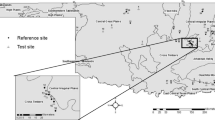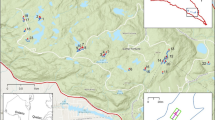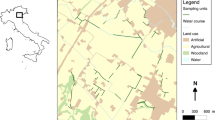Abstract
We applied established methods for wetland identification in lowland and montane wet forests (rain forests) on the island of Hawaii to determine whether rain forests exhibited wetland indicators specified in delineation manuals and to examine relationships among indicators of hydrophytic vegetation, hydric soils, and wetland hydrology. Morphological characteristics and ferrous iron tests indicated pockets of hydric organic soils within areas mapped as Folists. Hydrophytic vegetation decisions based on prevalence values agreed with hydric soil determinations more often than did decisions based on dominant plant species. None of the rain forest types we studied exhibited wetland indicators throughout, but some sites contained scattered small wetlands occupying microtopographic lows created by cracks, folds, and undulating flow patterns in the lava bedrock. Further work is needed to identify reliable wetland indicators that can be used during drier portions of the year and to distinguish hydric from nonhydric organic rain forest soils.
Similar content being viewed by others
Literature Cited
Adams, D. A., M. A. Buford, and D. M. Dumond. 1987. In search of the wetland boundary. Wetlands 7:59–70.
Carter, V., P. T. Gammon, and M. K. Garrett. 1994. Ecotone dynamics and boundary determination in the Great Dismal Swamp. Ecological Applications 4:189–203.
Char, W. P. and C. H. Lamoureux. 1985. Puna geothermal area biotic assessment, Puna District, County of Hawaii. Final Report to the Hawaii State Department of Planning and Economic Development. Honolulu, HI, USA.
Childs, C. W. 1981. Field tests for ferrous iron and ferric-organic complexes (on exchange sites or in water-soluble forms) in soils. Australian Journal of Soil Research 19:175–180.
Cuddiby, L. W. 1989. Vegetation zones of the Hawaiian Islands. p. 27–37.In C. P. Stone and D. B. Stone (eds.) Conservation Biology in Hawai’i. Cooperative National Park Resources Studies Unit. University of Hawaii, Manoa, HI, USA.
Environmental Laboratory. 1987. Corps of Engineers wetlands delineation manual. U.S. Army Engineer Waterways Experiment Station, Vicksburg, MS, USA. Fechnical Report Y-87-1.
Federal Interagency Committee for Wetland Delineation. 1989. Federal Manual for Identifying and Delineating Jurisdictional Wetlands. Cooperative Technical Publication. U.S. Army Corps of Engineers, U.S. Environmental Protection Agency, U.S. Fish and Wildlife Service, and U.S.D.A. Soil Conservation Service, Washington, DC, USA.
Gagne, W. C. and L. W. Cuddihy. 1990. Vegetation. p. 45–114.In W. L. Wagner, D. R. Herbst, and S. H. Sohmet. Manual of the Flowering Plants of Hawai’i. Vol. 1. University of Hawaii Press, Honolulu, HI, USA. Bishop Museum Special Publication 83.
Hodges, C. S., K. T. Adee, J. D. Stein, H. B. Wood, and R. D. Doty. 1986. Decline of ohia (Metrosideros polymorpha) in Hawaii: a review. U.S. Forest Service, Washington, DC, USA. General Technical Report PSW-86.
Holcomb, R. T. 1980. Preliminary geologic map of Kilauea Volcano, Hawaii. U.S. Geological Survey, Washington, DC, USA. Open File Report 80-796.
Jacobi, J. D. 1989. Vegetation maps of the upland plant communities on the islands of Hawai’i, Maui, Moloka’i, and Lana’i. U.S. Fish and Wildlife Service, Washington, DC, USA. Cooperative National Park Resources Studies Unit, Technical Report 68.
Josselyn, M. N., S. P. Faulkner, and W. H. Patrick, Jr. 1990. Relationships between seasonally wet soils and occurrence of wetland plants in California. Wetlands 10:7–26.
Lockwood, J. P., P. W. Lipman, L. D. Petersen, and E. R. Warshauer. 1988. Generalized ages of surface lava flows of Mauna Loa Volcano, Hawaii. U.S. Geological Survey, Washington, DC, USA. Misc. Investigations Series, Map I-1908.
Mueller-Dombois, D. 1985. Ohi’a dieback and protection management of the Hawaiian rain forest. p. 403–421.In C. P. Stone and J. M. Scott (eds.) Hawai’i’s Terrestrial Ecosystems: Preservation and Management. Cooperative National Park Resources Studies Unit, University of Hawaii, Honolulu, HI, USA.
National Research Council. 1995. Wetlands: Characteristics and Boundaries. National Academy Press, Washington, DC, USA.
Neal, M. C. 1965. In gardens of Hawaii. 2nd edition. Honolulu, HI, USA. Bishop Museum Special Publication 50.
Reed, P. B., Jr. 1988. National list of plant species that occur in wetlands: Hawaii (Region H). U.S. Fish and Wildlife Service, Washington, DC, USA. Biological Report 88(26.13).
Sato, H. H., W. Ikeda, R. Pacth, R. Smythe, and M. Takchiro, Jr. 1973. Soil survey of the Island of Hawaii, State of Hawaii. U.S.D.A. Soil Conservation Service, Washington, DC, USA.
Segal, D. S., P. J. Latham, and G. R. Best. 1987. Delineating a wetland boundary using vegetative, soil and hydrologic characteristics: a Florida cypress dome example. Wetlands 7:51–58.
Segelquist, C. A., W. L. Slauson, M. L. Scott, and G. T. Auble. 1990. Synthesis of soil-plant correspondence data from twelve wetland studies throughout the United States. U.S. Fish and Wildlife Service, Washington, DC, USA. Biological Report 90(19).
Soil Survey Staff. 1951. Soil Survey Manual. U.S.D.A. Soil Conservation Service. Washington, DC, USA. Agricultural Handbook No. 18.
Soil Survey Staff. 1975. Soil taxonomy: A basic system of soil classification for making and interpreting soil surveys. U.S.D.A. Soil Conservation Service, Washington, DC, USA. Agricultural Handbook No. 436.
Soil Survey Staff. 1992. Keys to Soil Taxonomy, 5th ed. Pocahontas Press, Blacksburg, VA, USA. SMSS Technical Monograph 19.
U.S.D.A. Soil Conservation Service. 1991. Hydric Soils of the United States. Washington, DC, USA. Miscellancous Publication No. 1491.
Wagner, W. L., D. R. Herbst, and S. H. Sohmer. 1990. Manual of the Flowering Plants of Hawai’i Vol. 1 and 2. University of Hawaii Press, Honolulu, HI, USA. Bishop Museum Special Publication 83.
Wentworth, T. R., G. P. Johnson, and R. L. Kologiski. 1988. Designation of wetlands by weighted averages of vegetation data: a preliminary evaluation. Water Resources Bulletin 24:389–396.
Author information
Authors and Affiliations
Rights and permissions
About this article
Cite this article
Wakeley, J.S., Sprecher, S.W. & Lichvar, R.W. Relationships among wetland indicators in Hawaiian rain forest. Wetlands 16, 173–184 (1996). https://doi.org/10.1007/BF03160691
Received:
Revised:
Accepted:
Issue Date:
DOI: https://doi.org/10.1007/BF03160691




